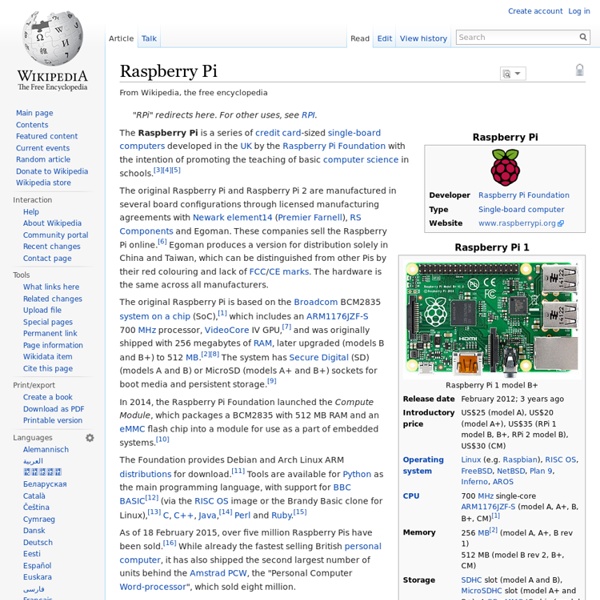Raspberry Pi

http://en.wikipedia.org/wiki/Raspberry_Pi
Related: Raspberry Pi
Gav's World : Raspberry Pi : Car Media Server
Raspberry Pi Car Media Server [gav-pi2] It was extremely simple to set up... eventually... once I'd battled with RaspBMC for a couple of nights (it's too constrained to do a particular job - although it does it very well) and switched to Raspbian... The thick yellow (orange externally), red and black wires carry +12V, +12V (accessory) and GND from the car.
ET-ARM Stamp
Our very popular ET-ARM Stamp Module is ideal for the ARM programmer. This Module incorporates the latest Philips LPC2119 Micorocontroller, which is based on the high-performance 16/32 bit ARM7TDMI-S CPU Core. This microcontroller includes real-time emulation and embedded trace support, together with a whopping 128k of high access speed Flash Memory. This module really delivers with high 32-bit speed combined with a large memory area, together with a host of peripherals to support the most demanding applications, all at a very competitive price. Programs can be downloaded directly to the module via a simple RS-232 Connection on the module, with easy-to use download software combined with the boot-loader already installed on the chip.
Raspberry Jam at Milton Keynes – National Museum of Computing – Gertboard Demo Rig
Yesterday I went to my first Raspberry Jam – a get-together of Raspberry Pi enthusiasts. This one was in Milton Keynes at the National Museum of Computing. It happened to be run by Peter Onion, who I already knew from the world of aeromodelling. So it was a no-brainer for me to go to… meet an old friend (he’s not that old)visit a museum of computersget to talk to people about the Raspberry Pi and Gertboard and demonstrate themsee what other people are doing with the Pi (nobody else had a Gertboard – ner ner nee ner ner :p )
View topic - [Tutorial] In-Car Raspberry with Wifi Access point - DWA-121
My car is a Renault Espace with integrated screens at the back of the headrests (infrared transmitter for the sound to headsets) with a DVD Player and an extra RCA audio/video input. Since I was bored with kids battles choosing cartoons from old DVDs I decided to use a Raspberry Pi together with Raspbmc as a media center. Everything had to be powered from the cigar lighter receptacle...
An Open community portal for Texas Instruments AM1808 / OMAPL138 platform — hawkboard.org
Build your own DIY Roomba-style robot vacuum cleaner
The CleanBOT: a DIY autonomous floor cleaning robot Do you want a DIY service robot able to clean the floor of your house? The Instructables user MosfetN shows you what you need and how to build a cheap vacuum cleaner. In other words, you can build at home a robot with almost all features of a Roomba vacuum cleaner. The designer says that the CleanBOT is a robot vacuum cleaner featured to work in two different ways: vacuum or active mop.
leaflabs.com
Plus de 50 idées pour votre Raspberry Pi
Nous sommes nombreux à nous être procuré un petit ordinateur Raspberry Pi pour nous lancer dans des projets de ouf malade... C'est très cool, mais à part le classique Media Center XBMC, qu'avez-vous fait avec votre Raspberry Pi ? Si vous séchez niveau idées, voici une petite sélection que j'ai rassemblée au cours des derniers mois. J'imagine qu'il y a encore beaucoup d'autres idées et de tutos, donc n'hésitez pas à partager les liens dans les commentaires, je les rajouterai à ma liste.
Main Page - Raspiface
GreenPiThumb: A Raspberry Pi Gardening Bot - mtlynch.io
Introduction This is the story of GreenPiThumb: a gardening bot that automatically waters houseplants, but also sometimes kills them. The story begins about a year ago, when I was struck by a sudden desire to own a houseplant. A plant would look nice, supply me with much needed oxygen, and imply to guests that I’m a responsible grown-up, capable of caring for a living thing. But I’m a programmer, not a gardener.
amazon
Related:


